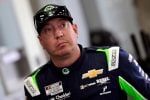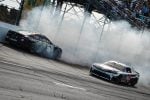Opportunity is key to success in racing. For drivers from a region that’s not typically associated with NASCAR, finding the right opportunity can be even more daunting.
But sometimes things just click, and for Berlin, Connecticut-native Ryan Preece, that’s happened in 2025 at RFK Racing.
At 34, Preece has put up career-best totals in top fives, top 10s, average start, average finish and lead-lap finishes. Unfortunately, he narrowly missed a playoff berth.
But the road to his recent success has been a long one.
The former Whelen Modified Tour champion sat down with Amy Henderson at New Hampshire Motor Speedway and talked about what owner Brad Keselowski has taught him, his start in racing with his father and brothers, and the opportunities — and obstacles — out there for young racers in the Northeast.
Amy Henderson: You’re having a career year this year in the Cup Series in your first year at RFK Racing. It seems like you jumped right in and you’re running right up there with Chris Buescher and Brad Keselowski. What’s different (from your previous opportunities)? Is it more stability? Obviously, the equipment’s very good.
Preece: Yeah, I think there’s a multitude of things. You know, perspective. I feel like I’ve been using that word a lot this year, but it’s true. You’ve got three different drivers and three different styles of how they go about doing things. Not only on the race track, but how they work within their race team.
So for me, going into this season, it was understanding my flaws of what I do as a racecar driver, and how can I make them better and how can I be a better teammate to Chris or Brad. Also, changing the style of what I do and how I go about things and just open that up.
There’s a side of this team that was put together, how it was put together, and that was done by Brad and everybody at RFK. I think it’s gone really way better than everybody could have anticipated.
Going into this year, this was a make-or-break thing. Performance was a must, on all fronts for everybody. So to see a lot of things come together the way they did, and for us, we had opportunities to win races, and it just didn’t didn’t come together.
But I think for me, a lot of a lot of reporters and drivers, you talk about gelling and taking time to gel. And in the environment and the world we live in in NASCAR right now, it either happens or it doesn’t. And if there’s one thing that drivers don’t have right now in their careers is time. People are always immediately looking for a change and quick to pull the trigger.
It’s been nice to have a group, a company like RFK, to build up with and you have three teams that are working truly hard together and seeing each other progress.
Henderson: I saw somewhere how many of this year’s playoff drivers came through Brad’s Truck program (five in the round of 12). Obviously, he knows what he’s doing.
Preece: Brad has impressed me as a racecar driver, looking at an owner, looking at another driver as a teammate. You know, there’s a lot of racecar drivers that they don’t see the entire picture. And Brad is somebody who sees the entire picture. A lot of people can act like they can, but I promise you, I’m even guilty of thinking I see a lot of it, but there’s truly times where I can have conversations with Brad, and it opens my eyes and gives perspective.
So, for me, I can 100% see why a lot of the guys that were a part of his program and he put in those racecars why they’re successful. Even when I’m sure other people didn’t see that success in those drivers at that time, you know, Brad did.
Hearing his story from him, and the things that I can relate to. The hardships that you go through, he is a racer.
Henderson: The Modifieds are a big deal here at New Hampshire Motor Speedway. I was surprised I didn’t see you out in there in one.
Preece: You know, there’s a lot of things I wish I could do and want to do, but I am I’m very competitive, so if I don’t have the time to be able to show up here and feel like I have a shot to win, I’m too competitive to show up and half-ass something.
Henderson: Right. As far as your path in racing — you started in Modifieds at what, 17, somewhere in there?
Preece: It’s actually 14 or 15, but the Whelen Modified Tour, my first year I was 16.
Henderson: What did you do before that?
Preece: My family and had been in racing. I started off in quarter midgets locally, in Connecticut, just like Joey Logano; he started off in Meriden, Connecticut. I started off in Meriden, Connecticut, and raced Silver City and all that. Well, I have two older brothers, and one of my older brothers was actually pretty good, and he was older, so he would move up some divisions. He was running dirt micros, at Whip City in Massachusetts, and you know, I just kind of followed his footsteps. So I ran go-karts, at kind of about the age of when he was in high school and doing other things.
My passion for it just stayed really strong. So, I moved into dirt micros as well, asphalt micros, and then I was I was racing at Mahoning Valley. I think I was 13, and a guy put me in his modified, so when that happened, I kind of got the taste for it.
We sold that asphalt 600 cc micro sprint, and then got our first turnkey modified.
I remember it was a 1992 or 1993 Troyer modified with a 23-degree motor. We sold our micro for $10,000 and bought that for $10,000, so that’s what we did.
Henderson: Opportunities (for young racers) like Bandoleros, the smaller cars like that, are newer up here in New England. It seems like that was more of a Charlotte thing, a Southern thing for a long time.
Preece: Yeah, I don’t really notice it up here as much. I think the prevalence and the things that are more common is, kids, at least in Connecticut, because that’s where I’m from, they race quarter midgits or they run go karts ay Stafford Motor Speedway on Monday nights. And typically, when they … turn 16 or when they get enough experience, they’re in a tour-type modified or they’re in an SK modified or they’re in an ACT late model or a super late model of some sort.
Henderson: Obviously, you’re a Modified champion and that’s a way to get to get noticed and get eyes on you. What other opportunities are there for young drivers?
Preece: Certain people can bring attention upon certain series. You can also use Kyle Larson and Christopher Bell as examples. Toyota did a lot for that proving grounds with the 410 sprint cars and the midgets and all those things. So those guys brought a lot of eyes in that area.
Many years before that, it kind of seemed like super late models in the Southeast were the area of what owners were kind of keeping up with and paying attention.
Before that it was also USAC midget, sprint cars and Silver Crown drivers like Bobby Santos and Tyler Walker and many, many names.
I just feel like there’s probably less of us in the Northeast, and you’re trying to make an impact, but it takes a lot of things to bring the eyes to this part of the country.
Henderson: I feel like there’s a difference in the way drivers who pay their dues and come up through the ranks and how they’re perceived in the sport.
Preece: Yeah, that’s part of racing. It’s the stories, the family sacrifices, the sponsors that come with you. That’s what makes racing great, because we drive racecars, but a lot of it was this guy was a mechanic, or this guy was a plumber, and he raced on weekends. It’s no different than what Dale Earnhardt‘s story was many, many years ago, his hardships. So that’s what makes racers great. And I think at the end of the day, the respect that you carry through the garage on how you get there, as well as the respect you carry with race fans, is a huge piece of it.
I met some local mini-stock racers. I don’t even know them, but they said because of the route that I’ve taken and the road that it’s been, they respect it. That to me, that means just as much as anything when it comes to my career, because having the respect of the people that are up in this part of the country, it means a lot to me.
Amy is an 20-year veteran NASCAR writer and a six-time National Motorsports Press Association (NMPA) writing award winner, including first place awards for both columns and race coverage. As well as serving as Photo Editor, Amy writes The Big 6 (Mondays) after every NASCAR Cup Series race. She can also be found working on her bi-weekly columns Holding A Pretty Wheel (Tuesdays) and Only Yesterday (Wednesdays). A New Hampshire native whose heart is in North Carolina, Amy’s work credits have extended everywhere from driver Kenny Wallace’s website to Athlon Sports. She can also be heard weekly as a panelist on the Hard Left Turn podcast that can be found on AccessWDUN.com's Around the Track page.





